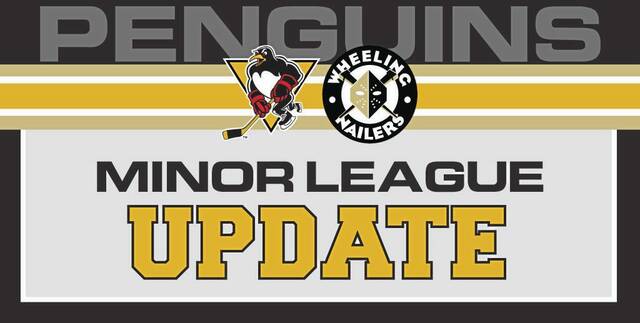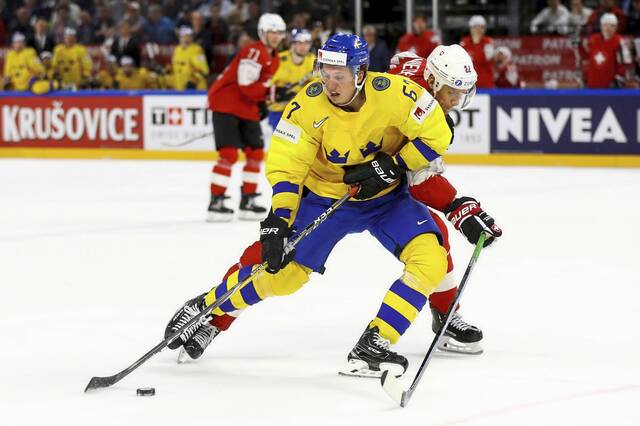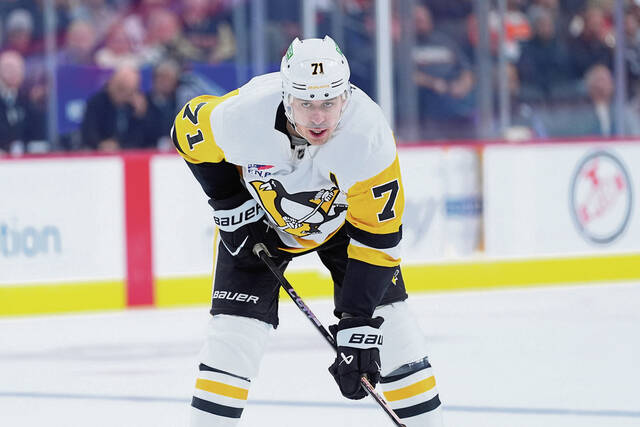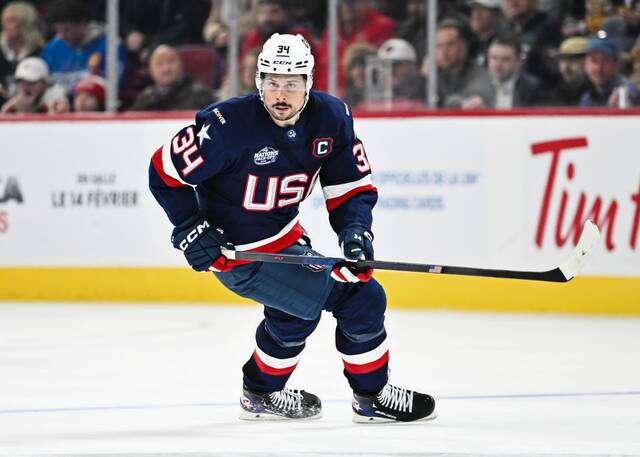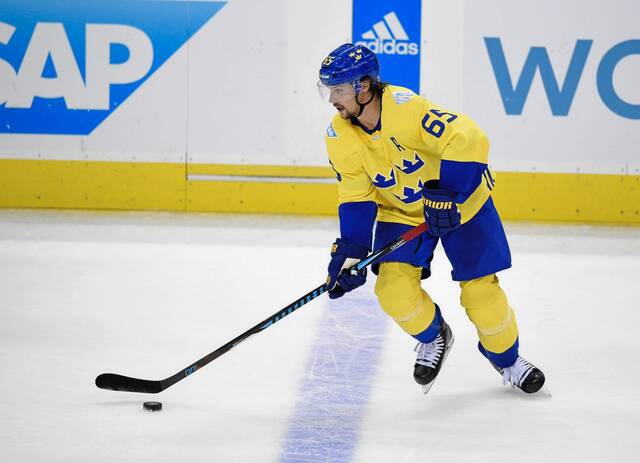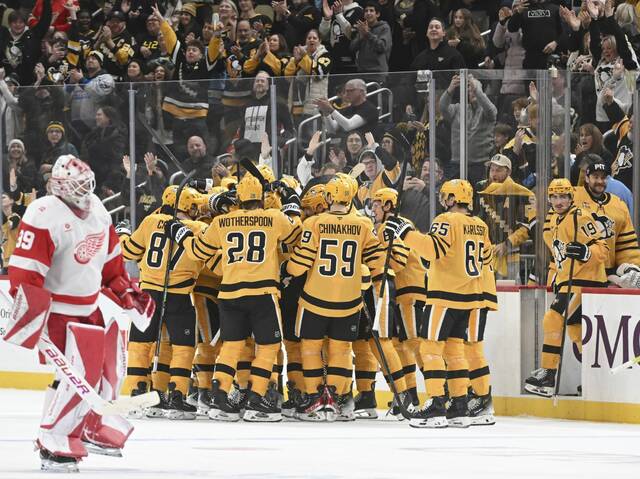While the NHL is on hold because of the ongoing coronavirus pandemic, the Tribune-Review will offer the Double Team project, an examination of the five best players who have contributed substantially to the Penguins and another franchise. For consideration, a player must have played at least the equivalent of a full season for each franchise. (Sorry, Jarome Iginla fans.)
Today, a look at the Buffalo Sabres, who entered the NHL in 1970. They might have been part of the league’s expansion class of 1967 but Steelers owner Art Rooney convinced his friends within Norris family, owners of the Detroit Red Wings and Chicago Black Hawks, to steer a franchise to Pittsburgh instead. In 194 all-time games against the Sabres, the Penguins own a 90-54-40 record.
1. Tom Barrasso, goaltender
Barrasso took an unusual route to the NHL in that he went directly from high school in Massachusetts to Buffalo. The fifth overall pick in the 1983 draft, Barrasso bypassed going to Providence University and made his NHL debut that fall at the age of 18, virtually unheard of for a goaltender, even today.
In his debut season, Barrasso appeared in 42 games and went 26-12-3 with a 2.84 goals against average and claimed the Vezina Trophy as the league’s top goaltender and Calder Memorial Trophy as top rookie.
He followed that up in 1984-85 by playing in 54 games and putting up a 25-18-10 with a league-leading five shutouts while claiming the William M. Jennings Trophy for allowing the fewest goals in the NHL as well as a spot in the All-Star Game.
Barrasso never lived up to the same standards in his next three seasons in Buffalo and by Nov. of 1988 he was dealt to the Penguins in a blockbuster trade. Rejuvenated by the transaction, Barrasso helped lead the Penguins to their first playoff appearance in seven years that spring.
Two years later in 1991, Barrasso backstopped the Penguins, who were never a defensive stalwart during this era, to the franchise’s first Stanley Cup title. They would repeat once again in 1992.
After leading the NHL in wins with 43 for the Penguins’ Presidents’ Trophy-winning squad in 1992-93 and finishing second in Vezina Trophy voting, Barrasso’s career was pockmarked by injuries over the next four seasons before he rebounded in 1997-98 under defensive-minded coach Kevin Constantine. Finishing third in Vezina voting, Barrasso established a then franchise mark of seven shutouts.
By 2000, Barrasso, whose superb puckhandling allowed him to become the NHL’s career leader in assists by a goaltender with 48, was traded to the Ottawa Senators, leaving the Penguins as the franchise’s greatest netminder before Marc-Andre Fleury surpassed him by most measures.
2. Doug Bodger
The Sabres’ primary return on their trade of Barrasso was Bodger, an offensive defenseman the Penguins selected with one of their three first-round picks in 1984 along with forward Roger Belanger and some guy named Mario Lemieux.
Bodger fit in well with during the first years with Lemieux. As a puck-moving defenseman, he racked up solid but hardly spectacular offensive totals during parts of five seasons. In 299 career games with the Penguins, he put up 167 points (35 goals, 132 assists).
With the Sabres, Bodger was a consistent and reliable presence on the blue line but rarely stood out. Often teamed with future Hockey Hall Of Fame defenseman Phil Housley, Bodger was usually overshadowed. In eight years with Buffalo, Bodger played in 479 career games and put up 287 points (54 goals, 233 assists).
3. Stu Barnes
Selected No. 4 overall in the 1989 draft by the Winnipeg Jets, Stu Barnes never really fully realized his potential until the Penguins acquired him from the Florida Panthers via trade early in the 1996-97 season.
Barnes put up a solid 39 points (17 goals, 22 assists) in 62 games that campaign and helped the Penguins reach the postseason.
The following season, Barnes broke out by establishing career-bests in goals (30) and points (65) in 78 games.
Barnes was enjoying another productive season in 1998-99 with 20 goals in 64 games but was moved to the Sabres at the trade deadline. That spring, he helped Buffalo reach its second, and most recent, appearance in a Stanley Cup Final, losing to the Dallas Stars.
Over the next four seasons, Barnes was a solid producer for defensive-oriented Sabres teams which were typical of the dead puck era. His best season in Buffalo was 1999-2000, putting up 20 goals and 45 points in 82 games.
4. Matthew Barnaby, right winger
If the Barnes trade was pulled off today in the era of advanced analytics, there would be quite a bit of unrest among the locals, particularly with the return.
But in the late 1990s and early 2000s, rough-and-tumble antagonists had quite a bit of value and there were few better at that aspect of the game than Barnaby.
A fourth-round pick in 1992, Barnaby became a full-time NHLer in 1995-96 and led the NHL with 335 penalty minutes. Along with enforcer Rob Ray, Barnaby helped make the Sabres one of the most physically imposing teams in the NHL during the mid-1990s.
In addition to his ability to be obnoxious, Barnaby showed some touch with the puck putting up 19 goals, a healthy total for the defensive 1990s, in 68 games during 1996-97.
During the Penguins’ mammoth upset of the top-seeded Devils in the 1999 Eastern Conference quarterfinal round, Barnaby’s feud with New Jersey defenseman Lyle Odelein was at the forefront as the two players exchanged verbal barbs ranging in scope from Odelein’s resembling the Cornelius character from Planet of the Apes to the perceived cosmetic appeal of Barnaby’s wife.
In 129 career games with the Penguins, Barnaby accumulated 399 penalty minutes.
5. Dave Hannan, center
Selected in the 10th round of the 1981 draft, Hannan carved out an NHL existence with some mostly bad Penguins teams in the 1980s. A defensive, penalty-killing center, Hannan’s rookie season of 1982-83 saw him appear in 74 games and put up 33 points (11 goals, 22 assists).
Hannan spent most of the next two seasons with the Penguins’ AHL affiliate, the Baltimore Skipjacks, before reestablishing himself in the NHL during in 1985-86 by scoring 17 goals and 35 points in 75 games.
Early in 1987-88, Hannan was sent to the Edmonton Oilers as part of the blockbuster trade for star defenseman Paul Coffey. After winning the Stanley Cup in the spring of 1988 with Edmonton, Hannan returned to Pittsburgh as a waiver claim that fall. He helped the Penguins return to the playoffs in 1989 by appearing in 72 games and posting 30 points (10 goals, 20 assists).
After being waived in October of 1989, Hannan spent parts of three seasons with the Toronto Maple Leafs – including a stint with Team Canada for the 1992 Olympics — before being traded to Buffalo late in the 1991-92 season. With the Sabres, Hannan enjoyed a tenure over five seasons as a bottom-six forward on several playoff-caliber teams.
Hannan has a unique place in Sabres history having scored the winning goal in the franchise’s longest overtime game, a 1-0 home victory in Game 6 of a 1994 Eastern Conference quarterfinal series. His goal came at 5:43 of the fourth overtime period.
Honorable mentions: Wayne Primeau, center; Mike Ramsey, defenseman; Miroslav Satan, right winger; Eddie Shack, left winger; Conor Sheary, left winger.



